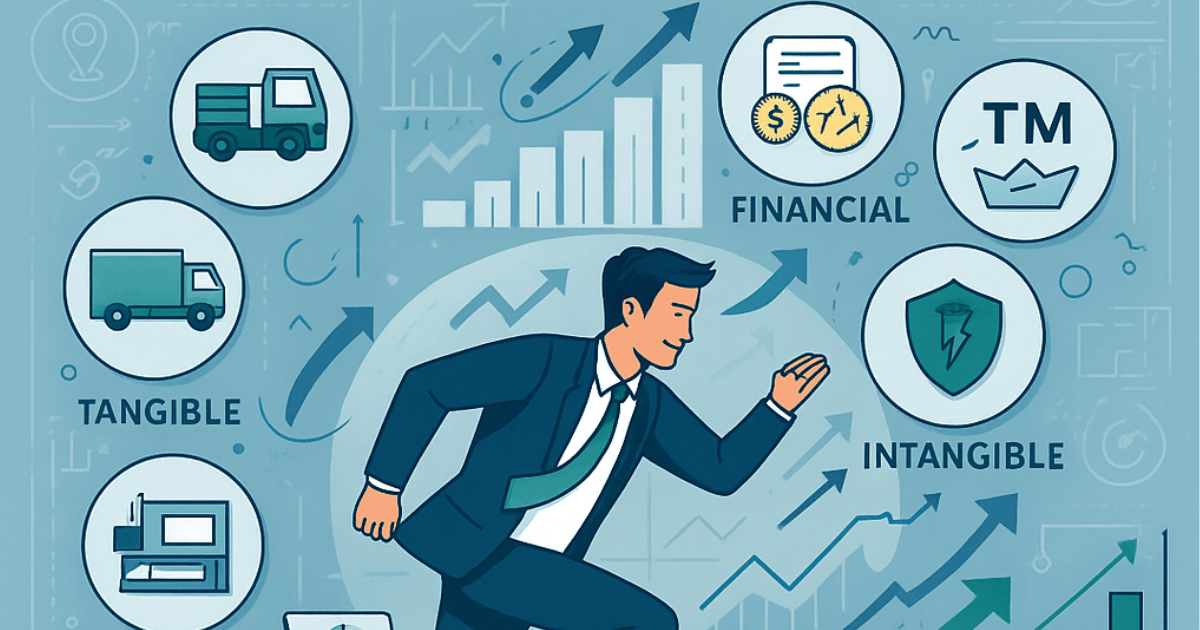Asset management serves as the cornerstone of entrepreneurial success, transforming from a simple accounting function into a strategic growth engine. This comprehensive guide explores how smart asset management drives sustainable business expansion and maximizes profitability.
Understanding Business Assets
What Are Assets?
An asset is any resource of value that a business owns or controls, expected to provide future economic benefits. For entrepreneurs, assets fall into three primary categories:
1. Tangible Assets
- Office equipment and machinery
- Vehicles and transportation
- Real estate properties
- Inventory and raw materials
- Physical infrastructure
2. Intangible Assets
- Intellectual property (patents, trademarks, copyrights)
- Brand reputation and goodwill
- Software licenses and technology
- Customer databases and relationships
- Proprietary processes and know-how
3. Financial Assets
- Cash and cash equivalents
- Accounts receivable
- Investment portfolios
- Securities and bonds
- Credit facilities
Strategic Asset Management Framework
Core Management Strategies
Asset Tracking & Inventory focuses on systematically monitoring all assets to prevent loss, theft, and underutilization. This involves implementing comprehensive tracking systems that record asset location, condition, and responsible parties.
Lifecycle Management encompasses planning the entire journey of an asset from acquisition through disposal. This strategy enables proactive cost control and optimal timing decisions for asset replacement or upgrades.
Performance Monitoring involves regularly assessing how effectively assets contribute to business objectives. This helps identify improvement opportunities and ensures assets deliver expected returns.
Maintenance & Upkeep establishes proactive maintenance schedules to prevent costly breakdowns while extending asset lifespan and ensuring operational continuity.
Strategic Acquisition & Disposal optimizes the asset portfolio through informed decisions about when to acquire, upgrade, or dispose of assets based on performance and strategic value.
Implementation Steps
- Establish comprehensive tracking systems that monitor all assets systematically
- Define performance metrics aligned with specific business objectives
- Create proactive maintenance schedules to prevent costly equipment failures
- Develop strategic acquisition criteria for optimal asset investments
- Set clear disposal protocols for underperforming or obsolete assets
Asset Management’s Impact on Business Growth
Direct Growth Benefits
- Optimized Resource Allocation
Effective asset management enables entrepreneurs to identify underutilized resources and reallocate them to growth-driving areas. This might involve redirecting capital from inefficient assets to expansion initiatives or redeploying equipment to higher-priority projects.
- Improved Operational Efficiency
Well-maintained and strategically deployed assets lead to streamlined operations, reduced downtime, and increased productivity. This operational agility becomes crucial when scaling business operations and meeting growing demand.
- Enhanced Financial Health
Strategic asset management minimizes unnecessary maintenance expenses while maximizing return on asset investments. This optimization frees up capital that can be directed toward strategic growth initiatives and business expansion.
- Data-Driven Decision Making
Accurate asset data provides the foundation for informed strategic planning. Entrepreneurs can make confident expansion and investment decisions when they have clear visibility into their asset portfolio’s performance and capabilities.
- Competitive Advantage
Businesses with efficient asset utilization can offer competitive pricing, faster service delivery, and higher quality outputs. This efficiency creates a sustainable competitive edge in crowded markets.
Cost Minimization Strategies
Proven Cost Reduction Techniques
- Preventative Maintenance Programs
Implementing scheduled maintenance prevents emergency repairs and extends asset lifespan. Regular upkeep is consistently more cost-effective than reactive repairs and reduces unexpected downtime that can disrupt business operations.
- Strategic Lease vs. Buy Analysis
Evaluating whether to lease or purchase assets requires careful consideration of usage patterns, capital availability, and expected lifespan. This analysis often reveals significant cost savings and improved cash flow management.
- Technology Integration
Modern asset management software, predictive maintenance analytics, and automated monitoring systems can dramatically reduce costs while improving efficiency. These tools provide real-time insights and prevent costly asset failures.
- Strategic Procurement Practices
Negotiating favorable acquisition terms, securing bulk purchase discounts, and establishing long-term supplier relationships can significantly reduce asset acquisition costs while ensuring quality and reliability.
- Asset Utilization Optimization
Eliminating idle time through better scheduling, sharing assets across departments when appropriate, and continuously monitoring productivity metrics ensures maximum value from every asset investment.
Essential Skills for Entrepreneurs
Core Competencies
- Financial Literacy
Entrepreneurs must understand asset valuation, depreciation calculations, ROI analysis, and cash flow implications. This knowledge enables informed decisions about asset investments and their impact on business profitability.
- Analytical Skills
The ability to interpret performance data, identify trends, and conduct cost-benefit analyses is crucial for optimizing asset management strategies. These skills help entrepreneurs make evidence-based decisions about their asset portfolio.
- Strategic Thinking
Long-term asset planning requires anticipating technology trends, aligning asset decisions with business goals, and forecasting future needs. Strategic thinking ensures asset investments support sustainable growth.
- Technological Proficiency
Modern asset management relies heavily on software solutions, data analytics tools, and digital systems. Entrepreneurs must be comfortable with these technologies to implement effective management strategies.
- Communication & Negotiation
Managing vendor relationships, communicating strategies to team members, and negotiating favorable contracts are essential skills for successful asset management. These abilities directly impact cost control and operational efficiency.
Implementation Roadmap
Phase 1: Assessment (Months 1-2)
Begin with a comprehensive asset inventory to understand what you currently own and its condition. Evaluate existing management practices and identify areas for improvement while establishing performance baselines for future comparison.
Phase 2: Planning (Month 3)
Develop a comprehensive asset management strategy that includes selecting appropriate tools and systems.
Phase 3: Implementation (Months 4-6)
Deploy chosen tracking and monitoring systems while training team members on new processes. Begin implementing preventative maintenance programs and start systematic performance monitoring across all asset categories.
Phase 4: Optimization (Ongoing)
Regularly analyze performance data to refine strategies based on actual results. Continuously improve processes and scale successful practices throughout the organization while adapting to changing business needs.
Measuring Success
Key Performance Indicators (KPIs)
Financial Metrics include asset return on investment, cost per asset hour, and total cost of ownership. Target ROI should typically exceed 15% for most asset investments.
Operational Metrics focus on uptime percentages, maintenance efficiency, and productivity improvements. Aim for 95% or higher uptime for critical business assets.
Strategic Metrics measure asset utilization rates and correlation between asset performance and business growth. Target 80% or higher utilization for optimal efficiency.
Risk Metrics track downtime incidents, compliance scores, and safety performance. Keep incidents below 5% of total operational time to maintain business continuity.
Technology Solutions for Asset Management
Modern Tools and Platforms
Cloud-Based Asset Management Systems provide real-time visibility into asset performance and location while enabling remote monitoring and management capabilities.
Internet of Things (IoT) Sensors can monitor equipment condition, usage patterns, and performance metrics automatically, providing valuable data for predictive maintenance.
Mobile Applications allow field teams to update asset status, report issues, and access maintenance schedules from anywhere, improving response times and accuracy.
Analytics and Reporting Tools transform raw asset data into actionable insights, helping entrepreneurs make informed decisions about their asset portfolio.
Common Pitfalls to Avoid
Critical Mistakes
Neglecting Regular Audits can lead to asset loss, theft, or misallocation. Conduct quarterly physical audits to verify asset records and condition.
Ignoring Depreciation Schedules affects financial planning and tax obligations. Maintain accurate depreciation records for all assets.
Delaying Maintenance to save money often results in higher costs and unexpected downtime. Invest in preventative maintenance programs.
Over-investing in Assets can strain cash flow and reduce flexibility. Carefully evaluate each asset purchase against business needs and growth plans.
Lacking Integration between asset management and other business systems creates inefficiencies and data silos. Choose solutions that integrate with existing workflows.
Future Trends in Asset Management
Emerging Developments
Artificial Intelligence and Machine Learning are revolutionizing predictive maintenance and asset optimization, enabling more accurate forecasting and automated decision-making.
Blockchain Technology offers enhanced security and transparency for asset tracking and ownership verification, particularly valuable for high-value assets.
Augmented Reality (AR) applications are improving maintenance procedures and training by providing real-time visual guidance and information overlay.
Sustainability Focus is driving demand for environmentally responsible asset management practices, including energy-efficient equipment and circular economy principles.
Conclusion
Effective asset management transforms from a necessary business function into a strategic advantage that fuels entrepreneurial growth. By implementing systematic approaches to asset tracking, maintenance, and optimization, entrepreneurs create a foundation for sustainable expansion and enhanced profitability.
The key lies in viewing asset management not as a burden, but as a strategic imperative that enables informed decision-making, operational efficiency, and competitive advantage in today’s dynamic business landscape. Success requires commitment to continuous improvement, investment in appropriate tools and training, and alignment of asset strategies with overall business objectives.
Through disciplined asset management, entrepreneurs can optimize resource allocation, minimize costs, and create the operational foundation necessary for scaling their ventures successfully. The investment in proper asset management systems and processes pays dividends through improved efficiency, reduced risks, and enhanced growth potential.

